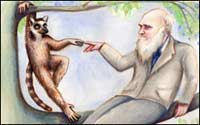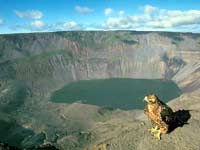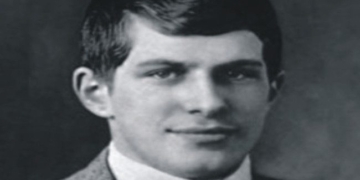Charles Darwin (1809 – 1882) and the Work “On the Origin of Species”
1809 was the birth year of several prominent figures in world history, such as Abraham Lincoln, the great emancipator, Charles Darwin, the renowned biologist, William Gladstone, the Prime Minister of England, Felix Mendelssohn, the talented composer, and poets like Edgar Allan Poe, Elizabeth Barrett Browning, and Alfred Tennyson.
Among these notable figures and millions born in the 19th century, except for Karl Marx, Charles Darwin profoundly changed the intellectual trends of Humanity, creating a new perspective.
Darwin’s book “On the Origin of Species by Means of Natural Selection” marked a turning point in modern Science, establishing a theory that has caused a stir until recently, profoundly influencing not only scientific thought but also Philosophy, Religion, and other ideological fields.
Today, the fundamental principles of Darwin’s theory are almost universally accepted within the scientific community, but it initially sparked controversy for nearly a century. It began in 1860 with debates in Oxford, followed by many other controversies, culminating in the 1925 “Monkey Trial” in Tennessee, USA, where debates gradually subsided over time.
1. The “Monkey Trial”.
 In 1925, the state of Tennessee passed the Butler Act, prohibiting the teaching of Evolutionary Theory in schools. Opposition arose, and a lawsuit was brought before the courts. The defendant was John T. Scopes, a 24-year-old science teacher and coach of the local football team. Scopes admitted to violating the law by teaching Charles Darwin’s theory. Thus, in July of that year, the “Scopes Monkey Trial” occurred, regarded by legal historians as the trial of the century.
In 1925, the state of Tennessee passed the Butler Act, prohibiting the teaching of Evolutionary Theory in schools. Opposition arose, and a lawsuit was brought before the courts. The defendant was John T. Scopes, a 24-year-old science teacher and coach of the local football team. Scopes admitted to violating the law by teaching Charles Darwin’s theory. Thus, in July of that year, the “Scopes Monkey Trial” occurred, regarded by legal historians as the trial of the century.
This case became the biggest headline across the United States, dominating all forms of information, newspapers, and radio broadcasts, clarifying arguments related to the United States Constitution, similar to issues of the separation of church and state, academic freedom, and the interpretation of the First Amendment. However, the characters involved in the controversy turned the trial into a spectacle.
 |
William Jennings Bryan – 1907 |
The defense attorney, Clarence Darrow, faced off against a three-time presidential candidate and staunch Christian, the renowned orator William Jennings Bryan. After the judge prohibited the introduction of expert scientific witnesses, Darrow called upon prosecutor Bryan to testify as a Biblical expert. In the sweltering heat of July, Darrow relentlessly questioned Bryan about the Bible, ultimately leading Bryan to admit that “the creation of man could take millions of years” and not just six days, as stated in Genesis. Thus, many believed that the defense attorney had triumphed in the Evolutionary debate. The defense’s strategy was to challenge the constitutionality of the Butler Act, while the prosecution argued that Scopes had violated the law. Ultimately, the jury concluded that Scopes was “guilty,” which was precisely what the defense wanted! This “guilty” verdict was appealed to the higher court, where the Butler Act would be struck down. However, the appeal was not heard until 1967, while several state education boards in the US had voted not to mention Evolutionary Theory in standardized test questions amid ongoing controversy.
2. The School and Survey Years of Charles Darwin.
Charles Robert Darwin was the grandson of two prominent and wealthy men living in Victorian England. His paternal grandfather, Erasmus Darwin, was a physician and a liberal thinker, while his maternal grandfather, Josiah Wedgwood, was the founder of the Wedgwood pottery and a leading figure in the Industrial Revolution in England. Charles Darwin’s father, Robert Darwin, was a skilled physician, and his mother was Susannah Wedgwood. Charles was born on February 12, 1809, into a family that included an older brother, Erasmus, who was four years his senior. They lived in a large house on the outskirts of Shrewsbury.
 |
Charles Darwin – 1816 |
As a child, Darwin showed no promise of becoming a renowned scientist. Despite coming from a family of scholars and professionals, Darwin was not an outstanding student. At elementary school, young Charles became frustrated with Latin and the rigid classical curriculum. He was reprimanded by the headmaster for wasting time on chemistry experiments and collecting insects and rocks. Following in his father’s footsteps, Charles was sent to Edinburgh University at the age of 16 to study Medicine. After two years at this school, he determined that medicine was not suitable for him and transferred to Cambridge University to prepare for a career in the Church of England.
Darwin considered his three years at university a waste of time, yet he greatly benefited from befriending two influential professors: John Stevens Henslow, a botany professor, and Adam Sedgwick, a geology professor. With their guidance, Darwin spent much time on field excursions, collecting various insects and practicing observation of nature.
Through Professor Sedgwick’s introduction, Darwin was offered the position of naturalist on the HMS Beagle, tasked with conducting a thorough survey of the southern hemisphere. The HMS Beagle was a small ship, 90 feet long and 24 feet wide, making Darwin’s quarters quite cramped. Years later, reflecting on this journey, Darwin considered it “the most important event in my life.” Over five years, from 1831 to 1836, the Beagle visited nearly all continents and major islands as it circumnavigated the globe. Darwin served in various roles including geologist, botanist, zoologist, and general scientist, which provided him with a solid preparation for his future research and writing career.
At each location, Darwin collected a wealth of plants and animals, fossils, and organisms, observing life forms on land and at sea. He studied the flora and fauna of various lands and oceans with the eyes of a naturalist, seeking numerous specimens in the wild fields of Argentina, the arid slopes of the Andes, the salt lakes or deserts of Chile and Australia, the dense forests of Brazil, Tierra del Fuego, and Tahiti, and the barren Cape Verde Islands. Darwin’s surveys also included geological formations along the coasts and mountains of South America, active or dormant volcanoes on islands or the mainland, coral islands, fossils of mammals in Patagonia, traces of human decline in Peru, and the indigenous peoples of Tierra del Fuego and Patagonia.
 | ||
Galapagos Islands However, through all the regions he had visited and studied, nowhere impressed Darwin more than the Galapagos Islands, located 500 miles off the coast of South America. On this lonely, uninhabited island, consisting only of barren volcanoes, Charles Darwin witnessed giant tortoises, enormous lizards never before seen in the world, and oversized crabs and sea lions. He also particularly noted that the birds here were similar to those on the nearby islands but not identical. Furthermore, there were variations in the different types of birds from one island to another. The strange phenomenon of the creatures on the Galapagos Islands, combined with the events that had surely been recorded earlier in South America, reinforced the ideas about evolution that were beginning to form in Darwin’s mind. Darwin noted in his journal: “I was especially surprised first by the fossils of scale-bearing animals like the existing armadillo, second by how closely related animals replaced each other on the continent as one moved southward, and third, the organisms changed slightly from one Galapagos Island to another, even though these islands are not very ancient in geological terms.” Charles Darwin did not immediately understand the significance of the changes in the external forms of organisms; he recorded all his observations to study later upon returning to England. He did not accept the doctrines in the Book of Genesis, which stated that all species were created at once and did not change over time. After returning to England, Charles Darwin published in 1839 the book “Journal of Researches into the Geology and Natural History of the Various Countries Visited by H.M.S. Beagle”, and he began to contemplate the theory of organic evolution, which posited that species change not only from place to place but also across geological ages. He sought to uncover the reasons for these changes and simultaneously wrote the book “The Origin of Species.” The first draft consisted of 35 pages written in 1842, and by 1844 it had expanded to 230 pages. From the start, the mysterious question was how to explain organic life that had begun developing since the Earth’s inception, to explain the emergence and disappearance of animal species. Why were species born, changed over time, divided into different branches, and often completely vanished? 3. Family Life and Scientific Research.
For 20 years, Charles Darwin compiled the aforementioned book “The Origin”, detailing his theories. He read countless materials: magazines, travel books, sports books, books on horticulture, animal husbandry, and natural history. He conversed with many breeders of plants and animals, sent questions to knowledgeable individuals, and collected skeletons of domesticated animals, comparing them with the bones of wild animals. He studied floating fruits and seeds that traveled on the ocean’s surface. He utilized the data gathered during his voyage on the Beagle to address many questions related to botany, zoology, geology, paleontology… Charles Darwin employed the method of artificial selection of domesticated animals and plants: dogs, cats, horses, wheat, barley, garden flowers… that humans had bred to obtain breeds beneficial for their needs. Thus, many new species had developed through selection. He reasoned that if evolution occurred through artificial selection, nature could also operate in the same manner through natural selection. However, in the natural environment, there was a struggle for survival. He observed that a significant number of species perished, with only a small fraction surviving. Some animals were food for others. The struggle continued relentlessly, and fierce competition eliminated any species unsuitable for survival. Changes in species occurred to meet the necessary conditions for survival. 4. The Birth of the Evolution Theory. The key to the mystery for Darwin came from reading Thomas Robert Malthus’s book “Essay on Population.” Malthus indicated that food supply controlled the level of population growth, and the increase in human numbers on Earth was curtailed by positive checks such as accidents, disease, war, and famine. Thus, similar factors could apply to organisms and plants. Darwin wrote: “From long observation of the habits of organisms and plants, I recognize that in the living conditions, species that adapt are often maintained, while those that do not adapt are destroyed. The result of this fact is that new species arise.”
Thus, Darwin’s famous theory of “natural selection,” “struggle for existence,” or “survival of the fittest,” was born, forming the foundation of the book “The Origin of Species.” Charles Darwin sought to establish substantial evidence, which made him hesitate to publish his research until the 1850s because his wife Emma was a devout Christian, often urging him to contribute to the church, assist the poor, and manifest piety. However, due to the urging of close friends, Darwin prepared a multi-volume work. Just as he was halfway through, a thunderous voice came to him. Charles Darwin received a letter from Alfred Russel Wallace, a senior scientist currently exploring biology in the Malay Archipelago. Wallace indicated that he was contemplating the origin of species and, like Darwin, was influenced by reading Malthus’s work. Wallace’s letter included a survey entitled “Essay on the Tendency of Varieties to Depart Indefinitely from the Original Type.” This was also Darwin’s confirmation. Charles Darwin found himself in a dilemma. Clearly, both of these individuals, through independent research, arrived at the same conclusions, while Darwin had spent many years thinking and searching, whereas Wallace’s idea was reached through intuition. Many scientists sympathetic to Darwin wanted him to receive credit for his long-standing research, so they arranged a presentation of the findings of both naturalists. Darwin and Wallace were invited to present their findings before the Linnaean Society, and the first text on the theory of evolution was published on the afternoon of July 1, 1858. Subsequently, both essays were published in the Journal of the Linnaean Society. Due to Wallace’s findings, Charles Darwin ceased drafting a massive work and instead wrote a summary study. By the end of 1859, Charles Darwin’s work became a milestone in the history of science and was published by John Murray in London. The first edition of 1,200 copies sold out within the first few days. Subsequent editions sold 24,000 copies in England alone and were translated into most major languages. The original title of Charles Darwin’s work was: “On the Origin of Species by Means of Natural Selection,” or “The Preservation of Favoured Races in the Struggle for Life.” The long title of the book was eventually shortened to: “The Origin of Species.” The fundamentals of Darwin’s theory were discussed in the first four chapters of “The Origin.” The subsequent chapters addressed geology, the distribution of plants and organisms, events relevant to classification, morphology and embryology, and finally led to the conclusion. The work “On the Origin of Species” describes the changes in animals and plants under human control, the transformations caused by “artificial selection” compared to changes in nature or “natural selection”. Darwin’s theory concludes that wherever there is life, there is change, and no two individuals are exactly alike. Within this transformation, there is also a struggle for survival and an exponential rate of increase. The work “Origin” shows that the principle of “natural selection” has acted to control the increase in the number of organisms. Some individuals of a species will be stronger, faster, smarter, less prone to disease, and better able to withstand harsh weather. These individuals will survive, while weaker organisms will decline. The white hare survives in the Arctic, while the brown hare is preyed upon by weasels and wolves. Giraffes, thanks to their long necks, survive by eating leaves high in trees, while those with shorter necks starve. Thus, changing circumstances have governed the survival of the fittest. Charles Darwin also mentions sexual selection, where the most adaptable males in their environment will leave the most offspring. Climate is also an important factor. Organisms that endure heat and cold while being able to forage will survive. All complex forms of life must adhere to the laws of nature, and the work “Origin” presents an ongoing process of evolution. 5. Controversies Surrounding Evolutionary Theory.
The work “On the Origin of Species” struck like a lightning bolt on a haystack. If this new and revolutionary theory held value, then the biblical story of God creating man would no longer be accepted. The Catholic Church, therefore, viewed Darwin’s propositions as dangerous to religion, leading to a storm of opposition. Although Darwin carefully avoided applying his theory to humanity, he was accused of implying that humans descended from monkeys. Many derisive remarks were made to dismiss Darwin’s theory. The Quarterly Review labeled Darwin as a superficial individual who tarnished the name of Science. He was even accused of collecting data to substantiate a “false principle.” At his old school, Trinity College, Cambridge, William Whewell forbade any copies of “Origin” from being placed in the school library. Among the conservative opponents was Robert Owen, a social reformer and industrialist in England, and Louis Agassiz, an American zoologist and geologist, both of whom argued that Darwin’s theory was a scientific fallacy that would soon be forgotten. The renowned British astronomer Sir John Herschel described the theory as “a haphazard law.” Darwin’s former geology professor, Sedgwick, considered Darwin’s theory to be a serious error. Nevertheless, Charles Darwin had many brave defenders. Leading among them were Sir Charles Lyell, a geologist; Thomas Huxley, a biologist; Sir Joseph Hooker, a botanist; and Asa Gray, a prominent American botanist. Among these esteemed figures, Darwin relied most on Huxley. Darwin did not publicly defend his theory; most of the defense came from Huxley’s capabilities during the meeting of the British Association in Oxford in 1860, which focused on Darwinism. Leading the opposition was Archbishop Wilberforce of Oxford. In his concluding speech, the Archbishop believed he could crush Darwin’s theory and turned to Huxley, mockingly asking, “I ask Professor Huxley, is it true that your grandfather or grandmother descended from monkeys?” Huxley turned to a friend and whispered, “God has delivered him into my hands!” Huxley then stood up and stated, “A man has no reason to be ashamed if he has a monkey as an ancestor. If I were to feel ashamed merely because a learned ancestor faced a question he could not answer, obscured that question with unintentional rhetoric, and distracted the audience with irrelevant remarks skillfully imbued with religious prejudice.” This was just one of many confrontations that occurred over decades between the Church and Science regarding Darwin’s theory. Through the work “Origin,” Charles Darwin lightly touched upon the origins of humanity, but later, in the book “The Descent of Man,” a significant amount of Darwin’s data demonstrated that humans are also a product of the laws of evolution, stemming from lower forms. Charles Darwin’s laws of evolution gradually came to be regarded as accurate, impacting many major academic fields. The theory of organic evolution was accepted by biologists, geologists, chemists, physicists, anthropologists, psychologists, educators, philosophers, sociologists, and even historians, political scientists, and philologists. Charles Darwin revolutionized not only the field of Biology but also had far-reaching effects on other scientific domains, from Astronomy to History, from Paleontology to Psychology, from Embryology to Religion. Consequently, Charles Ellwood declared that Charles Darwin deserved the highest honors accorded to a Thinker for bringing about the most profound results in the 19th century. In the 20th century, Darwin’s theory, with its concept of natural selection, was misappropriated by the Nazi regime for propaganda and the extermination of certain minority groups. Wars between nations were falsely justified as a means to eradicate the weak, and later, when vying for power, Marxist Communists also applied the theory of struggle for survival to their doctrine of “class struggle.” Charles Darwin passed away on April 19, 1882, due to heart disease. This sad news was reported by many newspapers, as by this time, his theory had gained widespread recognition. The London Standard newspaper wrote: “Faithful Christians can accept the facts of the Law of Evolution just as they have done with Astronomy and Geology, not because of biases from long-held and favored beliefs.” Charles Darwin wished to be buried in the village of Downe, Kent, but the scientific community of England honored him by interring his remains at the famous Westminster Abbey, alongside the grave of another renowned scientist from around the world, Sir… Leave a Reply |










































 On January 19, 1839, Charles Darwin married his close cousin Emma Wedgwood. The couple resided in Bloomsbury in a house that contained many specimens resembling a museum, and three years later, they moved to the village of Downe in Kent, a remote countryside area. The Darwins had 10 children, two of whom died young; a daughter named Annie, the most beloved, passed away at the age of 10, while the remaining seven children were all frail.
On January 19, 1839, Charles Darwin married his close cousin Emma Wedgwood. The couple resided in Bloomsbury in a house that contained many specimens resembling a museum, and three years later, they moved to the village of Downe in Kent, a remote countryside area. The Darwins had 10 children, two of whom died young; a daughter named Annie, the most beloved, passed away at the age of 10, while the remaining seven children were all frail.
 Contrary to popular belief, Charles Darwin was not the first figure to discover the theory of evolution. Prominent scientists like Buffon, Goethe, Erasmus Darwin (Charles Darwin’s grandfather), Lamarck, and Herbert Spencer had advocated for this theory. However, Darwin’s contribution was that he gathered comprehensive data to prove evolution and expanded on the theory of natural selection through his interpretation of the evolutionary process.
Contrary to popular belief, Charles Darwin was not the first figure to discover the theory of evolution. Prominent scientists like Buffon, Goethe, Erasmus Darwin (Charles Darwin’s grandfather), Lamarck, and Herbert Spencer had advocated for this theory. However, Darwin’s contribution was that he gathered comprehensive data to prove evolution and expanded on the theory of natural selection through his interpretation of the evolutionary process.









